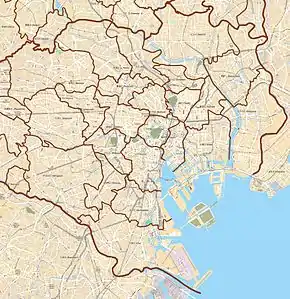JO22 JB22 Z13 Kinshichō Station 錦糸町駅 | |||||||||||||||||||||||||||||||||||||||||||||||
|---|---|---|---|---|---|---|---|---|---|---|---|---|---|---|---|---|---|---|---|---|---|---|---|---|---|---|---|---|---|---|---|---|---|---|---|---|---|---|---|---|---|---|---|---|---|---|---|
.jpg.webp) | |||||||||||||||||||||||||||||||||||||||||||||||
| General information | |||||||||||||||||||||||||||||||||||||||||||||||
| Location | 3 Kōtōbashi, Sumida, Tokyo (東京都墨田区江東橋3丁目) Japan | ||||||||||||||||||||||||||||||||||||||||||||||
| Operated by | |||||||||||||||||||||||||||||||||||||||||||||||
| Line(s) | |||||||||||||||||||||||||||||||||||||||||||||||
| Connections |
| ||||||||||||||||||||||||||||||||||||||||||||||
| Other information | |||||||||||||||||||||||||||||||||||||||||||||||
| Station code |
| ||||||||||||||||||||||||||||||||||||||||||||||
| History | |||||||||||||||||||||||||||||||||||||||||||||||
| Opened | 9 December 1894 | ||||||||||||||||||||||||||||||||||||||||||||||
| Passengers | |||||||||||||||||||||||||||||||||||||||||||||||
| JR East, FY2013 | 103,522 daily | ||||||||||||||||||||||||||||||||||||||||||||||
| |||||||||||||||||||||||||||||||||||||||||||||||
| Location | |||||||||||||||||||||||||||||||||||||||||||||||
 Kinshichō Station Location within Special wards of Tokyo  Kinshichō Station Kinshichō Station (Tokyo Bay and Bōsō Peninsula)  Kinshichō Station Kinshichō Station (Tokyo)  Kinshichō Station Kinshichō Station (Japan) | |||||||||||||||||||||||||||||||||||||||||||||||
Kinshichō Station (錦糸町駅, Kinshichō-eki) is a railway station in Sumida, Tokyo, Japan, operated by East Japan Railway Company (JR East) and Tokyo Metro. The surrounding area is the largest shopping district in Sumida Ward, featuring several large department stores, numerous small shops and restaurants.
Lines
Kinshichō Station is served by the JR East Sōbu Line (Rapid) and Chūō-Sōbu Line, as well as the Tokyo Metro Hanzōmon Line (Station number Z-13).
Station layout

JR East platforms
| 1 | JB Chūō-Sōbu Line | for Akihabara, Shinjuku, Nakano, and Mitaka |
| 2 | JB Chūō-Sōbu Line | for Shin-Koiwa, Funabashi, Tsudanuma, and Chiba |
| 3 | JO Sōbu Line (Rapid) | for Tokyo JO Yokosuka Line for Yokohama, and Kamakura |
| 4 | JO Sōbu Line (Rapid) | for Chiba, Narita, Kazusa-Ichinomiya, and Kisarazu |
Tokyo Metro platforms
.JPG.webp)
| 1 | Z Hanzōmon Line | for Otemachi and Shibuya DT Den-en-toshi Line for Chūō-Rinkan |
| 2 | Z Hanzōmon Line | for Oshiage TS Tobu Skytree Line for Tōbu-Dōbutsu-Kōen TI Tobu Isesaki Line for Kuki TN Tōbu Nikkō Line for Minami-Kurihashi |
History
The station first opened on 9 December 1894.[1] The Hanzōmon Line station opened on 19 March 2003.
The station facilities of the Hanzōmon Line were inherited by Tokyo Metro after the privatization of the Teito Rapid Transit Authority (TRTA) in 2004.[2]
Passenger statistics
In fiscal 2013, the JR East station was used by 103,522 passengers daily (boarding passengers only), making it the 36th-busiest station operated by JR East.[3] In fiscal 2013, the Tokyo Metro station was used by an average of 92,658 passengers per day (exiting and entering passengers), making it the 41st-busiest station operated by Tokyo Metro.[4] The daily passenger figures for each operator in previous years are as shown below.
| Fiscal year | JR East | Tokyo Metro |
|---|---|---|
| 1999 | 83,336[5] | |
| 2000 | 85,652[6] | |
| 2005 | 89,700[7] | |
| 2010 | 99,032[8] | |
| 2011 | 99,167[9] | 82,342[10] |
| 2012 | 101,250[11] | 89,233[12] |
| 2013 | 103,522[3] | 92,658[4] |
| 2020 | 74,343[13][lower-alpha 1] | 74,337[14][lower-alpha 1] |
- Note that JR East figures are for boarding passengers only.
Surrounding area
- Kinshi Park
- Sumida Triphony Hall (concert hall)
See also
Notes
- 1 2 Represents a significant ridership decrease owing to the impact of the COVID-19 pandemic on public transport.
References
- ↑ 各駅情報(錦糸町駅) [Station information (Kinshichō Station)] (in Japanese). Japan: East Japan Railway Company. Retrieved 22 November 2011.
- ↑ "「営団地下鉄」から「東京メトロ」へ" [From "Teito Rapid Transit Authority" to "Tokyo Metro"]. Tokyo Metro Online. 8 July 2006. Archived from the original on 16 May 2012. Retrieved 29 May 2022.
- 1 2 各駅の乗車人員 (2013年度) [Station passenger figures (Fiscal 2013)] (in Japanese). Japan: East Japan Railway Company. Archived from the original on 6 May 2001. Retrieved 13 September 2014.
- 1 2 各駅の乗降人員ランキング [Station usage ranking] (in Japanese). Tokyo Metro. Retrieved 13 September 2014.
- ↑ 各駅の乗車人員 (1999年度) [Station passenger figures (Fiscal 1999)] (in Japanese). Japan: East Japan Railway Company. Retrieved 13 September 2014.
- ↑ 各駅の乗車人員 (2000年度) [Station passenger figures (Fiscal 2000)] (in Japanese). Japan: East Japan Railway Company. Archived from the original on 9 October 2014. Retrieved 13 September 2014.
- ↑ 各駅の乗車人員 (2005年度) [Station passenger figures (Fiscal 2005)] (in Japanese). Japan: East Japan Railway Company. Archived from the original on 9 October 2014. Retrieved 13 September 2014.
- ↑ 各駅の乗車人員 (2010年度) [Station passenger figures (Fiscal 2010)] (in Japanese). Japan: East Japan Railway Company. Archived from the original on 6 October 2014. Retrieved 13 September 2014.
- ↑ 各駅の乗車人員 (2011年度) [Station passenger figures (Fiscal 2011)] (in Japanese). Japan: East Japan Railway Company. Archived from the original on 8 October 2014. Retrieved 2 September 2014.
- ↑ 駅別乗降人員順位表(2011年度1日平均) [Station passenger figures (Fiscal 2011)] (in Japanese). Japan: Tokyo Metro. Retrieved 13 September 2014.
- ↑ 各駅の乗車人員 (2012年度) [Station passenger figures (Fiscal 2012)] (in Japanese). Japan: East Japan Railway Company. Archived from the original on 7 October 2014. Retrieved 13 September 2014.
- ↑ 各駅の乗降人員ランキング (2012年) [Station usage ranking (2012)] (in Japanese). Tokyo Metro. Retrieved 13 September 2014.
- ↑ 各駅の乗車人員 (2020年度) [Station passenger figures (Fiscal 2020)] (in Japanese). Japan: East Japan Railway Company. Archived from the original on 5 July 2023. Retrieved 5 July 2023.
- ↑ 各駅の乗降人員ランキング (2020年) [Station usage ranking (2020)] (in Japanese). Tokyo Metro. Retrieved 5 July 2023.
External links
- JR East station information (in Japanese)
- Tokyo Metro station information (in Japanese)